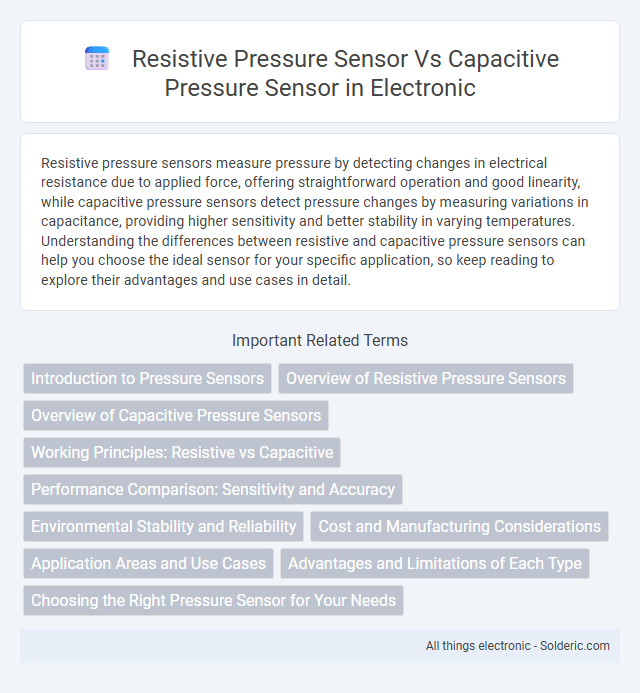Resistive pressure sensors measure pressure by detecting changes in electrical resistance due to applied force, offering straightforward operation and good linearity, while capacitive pressure sensors detect pressure changes by measuring variations in capacitance, providing higher sensitivity and better stability in varying temperatures. Understanding the differences between resistive and capacitive pressure sensors can help you choose the ideal sensor for your specific application, so keep reading to explore their advantages and use cases in detail.
Comparison Table
| Feature | Resistive Pressure Sensor | Capacitive Pressure Sensor |
|---|---|---|
| Operating Principle | Change in electrical resistance due to pressure-induced strain | Change in capacitance caused by variations in distance between capacitor plates |
| Sensitivity | Moderate sensitivity | High sensitivity |
| Accuracy | Good, but affected by temperature | High accuracy and stability |
| Temperature Dependency | High, requires compensation | Low, better temperature stability |
| Cost | Low to moderate | Moderate to high |
| Durability | Less durable, susceptible to material fatigue | More durable, less mechanical wear |
| Response Time | Fast | Fast |
| Applications | Industrial machinery, automotive, wearables | Medical devices, aerospace, high-precision instruments |
| Output Signal | Analog resistance signal, often converted to voltage | Capacitance change, converted to voltage or frequency |
Introduction to Pressure Sensors
Resistive pressure sensors operate by detecting changes in electrical resistance as pressure deforms a sensing element, offering high sensitivity and durability in various applications. Capacitive pressure sensors measure pressure changes through variations in capacitance caused by the movement of a diaphragm, providing excellent accuracy and low power consumption. Understanding the differences in response mechanisms helps you choose the appropriate pressure sensor based on your device's performance and environmental requirements.
Overview of Resistive Pressure Sensors
Resistive pressure sensors operate by measuring the change in electrical resistance caused by applied pressure on a sensing element, typically made of materials like metals or conductive polymers. These sensors are valued for their simplicity, durability, and cost-effectiveness in applications requiring direct pressure measurement. Your choice of a resistive sensor may depend on factors such as sensitivity requirements, environmental conditions, and compatibility with electronic interfaces.
Overview of Capacitive Pressure Sensors
Capacitive pressure sensors operate by detecting changes in capacitance caused by the deformation of a diaphragm under pressure, offering high sensitivity and accuracy for various applications. Unlike resistive pressure sensors, which rely on resistance changes in materials, capacitive sensors typically deliver better stability, lower power consumption, and faster response times. Your choice of a capacitive pressure sensor ensures precise measurements in environments requiring minimal signal drift and enhanced durability.
Working Principles: Resistive vs Capacitive
Resistive pressure sensors operate by measuring changes in electrical resistance caused by applied force deforming a strain gauge or conductive material. Capacitive pressure sensors detect pressure variations by measuring changes in the capacitance between two conductive plates separated by a dielectric, where applied pressure alters the distance or dielectric properties. The resistive principle relies on resistance modulation, while the capacitive principle depends on capacitance modulation for pressure detection.
Performance Comparison: Sensitivity and Accuracy
Resistive pressure sensors exhibit moderate sensitivity with performance influenced by material strain and structural design, making them suitable for applications requiring robust and cost-effective solutions. Capacitive pressure sensors offer higher sensitivity and superior accuracy due to their ability to detect minute changes in capacitance caused by pressure variations, resulting in precise and stable measurements. The intrinsic low noise and temperature compensation capabilities of capacitive sensors often outperform resistive types in demanding environments where precision is critical.
Environmental Stability and Reliability
Resistive pressure sensors offer high reliability in harsh environments due to their simple construction and fewer susceptibility issues with electromagnetic interference. Capacitive pressure sensors provide excellent environmental stability with superior resistance to temperature variations and humidity, enhancing measurement accuracy over time. In extreme conditions, capacitive sensors often exhibit better long-term durability, whereas resistive sensors may experience drift or degradation under prolonged mechanical stress.
Cost and Manufacturing Considerations
Resistive pressure sensors generally offer lower manufacturing costs due to simpler materials and fabrication processes, making them ideal for budget-sensitive applications. Capacitive pressure sensors involve more complex structures and require precise microfabrication techniques, resulting in higher production expenses but increased sensitivity and reliability. Your choice depends on balancing initial cost constraints with long-term performance needs in your specific application.
Application Areas and Use Cases
Resistive pressure sensors are extensively utilized in automotive systems, industrial machinery, and medical devices where robust performance under harsh conditions is critical. Capacitive pressure sensors find widespread application in consumer electronics, aerospace, and HVAC systems due to their high sensitivity and low power consumption. Each sensor type is chosen based on specific requirements such as environmental tolerance, accuracy, and response time in their respective use cases.
Advantages and Limitations of Each Type
Resistive pressure sensors offer high sensitivity and simple signal conditioning, making them ideal for low-cost and robust applications, but they suffer from temperature drift and limited durability under cyclic loading. Capacitive pressure sensors provide excellent stability, low power consumption, and superior frequency response, suitable for precision measurements, although they are more complex to manufacture and prone to parasitic capacitance effects. Choosing between resistive and capacitive pressure sensors depends on the specific requirements for accuracy, environmental conditions, and cost constraints.
Choosing the Right Pressure Sensor for Your Needs
Resistive pressure sensors excel in applications requiring cost-effective, simple pressure measurements with good linearity, making them suitable for low-pressure ranges and harsh environments. Capacitive pressure sensors offer higher sensitivity and stability, ideal for precise measurements and detecting minute pressure changes in clean and controlled settings. Assess your specific pressure range, accuracy requirements, and environmental conditions to choose the right pressure sensor for your needs.
resistive pressure sensor vs capacitive pressure sensor Infographic

 solderic.com
solderic.com